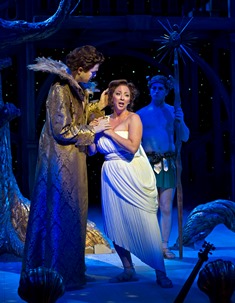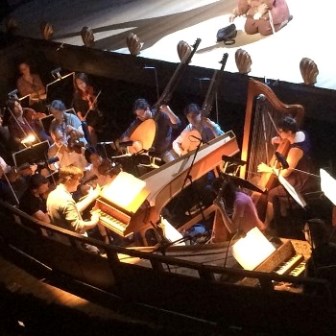
Cincinnati Opera's "Calisto" is Stylish Baroque Venture

(first published at classicalvoiceamerica.org)
It was the right place at the right time for 94-year-old Cincinnati Opera’s first-ever Baroque opera, Francesco Cavalli’s 1652 “La Calisto,” which opened July 17 for the first of five performances in Corbett Theater.
For Cincinnati Opera artistic director Evans Mirageas, who had long wanted to stage Baroque opera in Cincinnati, it was the perfect conjunction of events. Located just a block away from the Opera’s home in Music Hall, the new Corbett Theater is far more intimate (750 vs. 3,400 seats). With the eminent early-music ensemble Catacoustic Consort resident in Cincinnati (founded in 2001), the time for collaboration was ripe.
Chief performing space in the brand new School for Creative and Performing Arts, a K-12 magnet school, Corbett Theater is named for legendary Cincinnati arts patrons J. Ralph and Patricia Corbett. It will be used for smaller operas as part of Cincinnati Opera’s expanded “opera campus” in Cincinnati's newly revitalized Over-the-Rhine neighborhood. As such, it serves as a marked contrast to massive, red-brick Music Hall, an Over-the-Rhine landmark since 1878. The cozy, comfortable theater was first used for Cincinnati Opera’s ”Galileo Galilei” by Philip Glass in July, 2013.
"La Calisto," with a libretto by Giovanni Faustini, is based on tales from Ovid’s “Metamorphoses.” It tells of chief god Jove’s love affair with the nymph Calisto – a virgin devoted to the moon goddess Diana – and Diana’s love for the shepherd Endymion. A mix of bawdy comedy and deep feeling, it exemplifies what was choice entertainment for opera-mad Venetians in the 17thcentury. Staged by Ted Huffman, it brought the same mix to Corbett Theater. Sung in Italian with English surtitles, the work’s seamless blend of aria, recitative, and ensemble, stylishly ornamented by the singers, was handsomely presented, while the abstract period production was lovely to look at.
The cast of well-trained singers
was conducted by Baroque expert David Bates, director of London’s La
Nuova Musica. The performance edition was prepared especially for Cincinnati
Opera by French musicologist and keyboard artist Philippe Grisvard. With cuts,
it ran one hour and forty-five minutes. The instrumentation, played by a blend
of Catacoustic and Cincinnati Symphony Orchestra musicians, included
harpsichord, theorbo, Baroque guitar, Baroque harp, lirone, viola da gamba,
cello, double bass, violins, cornetto, recorder, and percussion– 18
players in all.

With scenic design by Cincinnati Opera’s David Centers, the production utilized the same set as for Glass’s“Galileo Galilei” last season — suggested, according to Cincinnati Opera, because both operas had an astronomical focus. A large orb (sun/moon) hung on the right, backed by wooden staircases and a walkway against a star-lit sky. An addition for “La Calisto” was a large tree trunk on the left, which provided a vantage point for numerous events during the opera. Costumes, by Cincinnati Opera’s Rebecca Senske, were eye-filling and sometimes scanty.
The production had some
hilarious trans-gender casting: The
aging nymph Linfea and Diana’s huntresses were played by men in drag, and
bass Daniel Okulitch, who sang Jove, also appeared in disguise as a
bosomy Diana (in order to get his paws on Calisto). This is one of
two ways to present "La Calisto”– and it worked beautifully; the other
(used in its revival at Glyndebourne in 1970) is to have the soprano who sings the real Diana also sing Jove-as-Diana.
“La Calisto” opens on an Earth parched after Phaethon (son of the sun god Helios) has driven his chariot too close to the sun and been brought down by Jove’s thunderbolt, raining devastation and drought on the Earth. (After a stroke of bass drum, the soft wash of theorbo, gamba, and harpsichord that rose from the pit made it clear that listeners were a long way from Verdi and Puccini.) Soprano Nathalie Paulin, as Calisto, set the tone with her sweet-voiced lament for the earth, “Piante ombrose.” Okulitch, as Jove, drew the first helpless laughter – not as Jove but as Diana, romancing Calisto in falsetto. Meanwhile, tenor Andrew Garland,as Jove’s sidekick Mercury, praised the art of deception.
Michael Maniaci, a rare male soprano with an international career, made his Cincinnati Opera debut as Endymion. His gentle, sincere voice made a perfect contrast to the hijinks of the other cast members, at the same time whetting one’s appetite for future appearances at Cincinnati Opera. (The American is a true male soprano who sings into the upper soprano register without use of falsetto. He graduated from the University of Cincinnati College-Conservatory of Music.)
Diana’s “huntresses,” who leaped across the stage like gazelles, drew plenty of laughs, especially tenor Thomas Michael Allen as the aging nymph Linfea, who mourns her superannuated virginity. Allen’s Linfea drew out a banana and took a bite as she sang of her desire for a husband. The unsated satyr Satirino – soprano Alisa Jordheim in fur, horns and a tail– stalked Linfea and pleaded his worthiness in “Io son d’origine.”
Tenor Aaron Blake was stellar as Pan, also aching with love for Diana (mezzo-soprano Jennifer Johnson Cano) in his heartfelt “Numi selvatici.” His band of satyrs consoled him with the lullaby “Pane consolati” as they rocked him to sleep. Maniaci and Cano shared one of the opera’s most touching moments as Endymion – who, fittingly, is also an astronomer – sang the beautiful aria “Lucidissima face” to the moon about his burning love for Diana as she comes upon him.
Act II followed this amorous web to its mixed conclusion. Soprano Alexandra Deshorties as Juno – who arrived with three black-shrouded Furies to the sound of wind machine and thunder sheet – sang a furious vengeance aria (“Dalle gelose mie cure incessanti”) and departed in triumph after turning Calisto into a bear. There was a charming ballet, actually a fight between the huntresses and satyrs, athletically choreographed by Zack Winokur and performed by members of Cincinnati Ballet.
The opera ended on a redeeming note as Jove revealed to the bear Calisto (Paulin with the head of a bear) that, though he cannot undo Juno’s work, she will join him after death as a constellation (Ursa Major).
In sum, “La Calisto” was one of the most enjoyable productions in recent seasons at Cincinnati Opera. With Catacoustic Consort as a potential partner and fine singers on hand (notably Maniaci), it portends well for more Baroque opera by the company in the future.
The opera repeats July 20, 23, 25 and 27 at the School for Creative and Performing Arts in Cincinnati. Information: (513) 241-2742. For tickets, call (513) 241-2742, or order online at www.cincinnatiopera.org